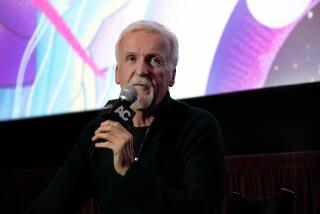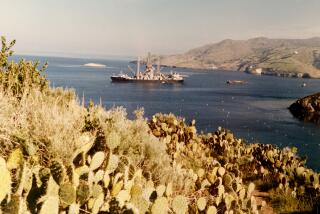‘Abyss’ Authenticity Didn’t Come Cheap
- Share via
For once, a studio’s boasts about a film’s authenticity are not exaggerated.
Even the most skeptical moviegoer will have no doubt that much of “The Abyss,” the undersea science-fiction love story that opened last week, was actually filmed underwater. The divers’ movements look like divers’ movements, there are clouds of bubbles everywhere, even one-man submersibles cruise next to Deepcore, the submerged oil-drilling rig where most of the action occurs.
But the credibility did not come easily, or inexpensively. Estimates on the cost of “The Abyss” range from $40 million to $60 million, and the production was so difficult for cast and crew members that some of them took to referring to the 20th Century Fox film as “The Abuse.”
Whatever the cost in money and nerves, the payoff is a tense underwater atmosphere that has never been seen on the screen before. As director James Cameron said, in one of the year’s great understatements: “This film required a lot of new hardware to realize these images and create this environment.”
During production, actors Ed Harris, Mary Elizabeth Mastrantonio, Michael Biehn and others wore helmets much of the time, rehearsing and performing in a 55-foot deep, 7.5-million gallon underwater set that had been created inside a never-completed nuclear power plant near Gaffney, S.C.
Anybody who’s been to a football game or seen a Jacques Cousteau documentary knows that when somebody is wearing a helmet, you wouldn’t know if it was Pee-wee Herman or Joe Montana. One of the chores for Cameron was to figure out how to get the audience to recognize which actor was doing what underwater.
So, Fox called in Western Space and Marine, a Santa Barbara company run by veteran marine engineer Scott Millard, to design 10 customized diving helmets.
“They did not want their working divers to look like they had been outfitted at a scuba shop,” Millard said.
Instead of the usual underwater diving mask and air hose running into an actor’s mouth, an enclosed fiberglass helmet with big plastic windows was designed that revealed the actor’s face from his forehead to his chin. The idea was to avoid the conventional Cousteau look and produce futuristic diving gear to be worn by blue-collar oil-rig roughnecks.
To ensure that the audience would recognize the actors, each helmet was also equipped with a fancy flashlight that looked much like a miner’s helmet light--shining a beam to help the divers see where they were going. Actually, most of the light was redirected inside the helmet to light up the actor’s face so Cameron would be free to shoot close-ups.
The diver’s backpacks had 15-volt batteries to run both the helmet light and a compressed air tank. Millard’s company even designed the air flow inside the helmet to prevent it from fogging up.
To preserve the illusion that the action was taking place in the dark, 2,000 feet below sea level, the crew put a layer of millions of black plastic beads on the surface of the water and then covered those with a massive tarp so that no light would penetrate.
Because the actors stayed underwater for hours at a time, the diving equipment had to be comfortable as well as safe. The helmets weighed up to 20 pounds each at sea level, but were custom-designed to allow the actors an almost weightless freedom of movement.
Air trapped inside a helmet will lift weight from a diver’s shoulders if properly balanced against the pressure of the surrounding water. To achieve this neutral buoyancy, Millard’s helmets were designed to carry strategically placed weights of lead shot and brass neck rings.
Each one was custom-fitted to the actor; petite Mary Elizabeth Mastrantonio, for instance, needed more weight in her helmet than heftier co-star Leo Burmester.
“This helmet is better than most on the (commercial diving market),” Millard said. “The balance is superb and the (air regulator) the best I’ve ever seen.”
To save shooting time, an underwater station was also designed by Millard and mechanical engineer Brian Macy so that the crew could fill up their air tanks without having to return to the surface. And to record the dialogue directly onto tape, the helmets had little headsets built into them with the kind of sensitive aviation mikes used by helicopter pilots.
Sound experts also laid miles of cable to complete an elaborate underwater communications system that allowed director Cameron, who spent plenty of time underwater himself, to direct the action both above and below the surface. Using a wireless loudspeaker system, he could even talk to the divers below.
With all the production delays, Cameron sometimes lost his temper, and when he did, everybody underwater and outside the tank heard him.
More to Read
Only good movies
Get the Indie Focus newsletter, Mark Olsen's weekly guide to the world of cinema.
You may occasionally receive promotional content from the Los Angeles Times.










